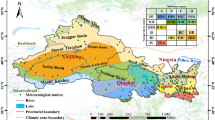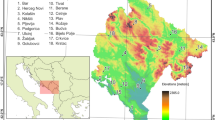Abstract
In order to better understand the effect associated with global climate change on Iran’s climate condition, it is important to quantify possible shifts in different climatic types in the future. To this end, monthly mean minimum and maximum temperature, and precipitation from 181 synoptic meteorological stations (average 1970–2005) have been collected from the meteorological organization of Iran. In this paper, to study spatial changes of Iran’s climatic zones affected by climate changes, Extended De Martonne’s classification (originally formulated by De Martonne and extended by Khalili (1992)) was used. Climate change scenarios were simulated in two future climates (average conditions during the 2050s and the 2080s) under each of the SRES A1B and A2, for the CSIRO-MK3, HadCM3, and CGCM3 climate models. Coarse outputs of GCMs were downscaled by delta method. We produced all maps for three time periods (one for the current and two for the future) according to Extended De Martonne’s classification. Finally, for each climatic zone, changes between the current and the future were compared. As the main result, simulated changes indicate shifts to warmer and drier zones. For example, in the current, extra arid-cold (A1.1m2) climate is covering the largest area of the country (21.4 %), whereas in both A1B and A2 scenarios in the 2050s and the 2080s, extra arid-moderate (A1.1m3) and extra arid-warm (A1.1m4) will be the climate and will occupy the largest area of the country, about 21 and 38 %, respectively. This analysis suggests that the global climate change will have a profound effect on the future distribution of severe aridity in Iran.





Similar content being viewed by others
References
Adle AH (1960) Climatic regions and vegetation in Iran. University of Tehran Press, Tehran, p 144
Bader DC, Covey C, Gutowski WJ, Held IM, Kunkel KE, Miller RL, Tokmakian RT, Zhang MH (2008) Climate models: an assessment of strengths and limitations. U.S. Climate change science program synthesis and assessment product 3.1. Department of Energy, Office of Biological and Environmental Research, 124 pp
Beck C, Grieser J, Kottek M, Rubel F, Rudolf B (2006) Characterizing global climate change by means of Koppen climate classification. DWD, Klimastatusbericht 2005:139–149
de Castro M, Gallardo C, Jylha K, Tuomenvirta H (2007) The use of a climate-type classification for assessing climate change effects in Europe from an ensemble of nine regional climate models. Clim Change 81:329–341
De Martonne E (1926) Une nouvelle fonction climatologique: L'indice d'aridité. La Meteorologie 2:449–458
Diaz HF, Eischeid JK (2007) Disappearing “alpine tundra” Koppen climatic type in the western United States. Geophys Res Lett 34:L18707. doi:10.1029/2007GL031253
Eischeid JK, Baker CB, Karl TR, Diaz HF (1995) The quality control of long-term climatological data using objective data analysis. J Appl Meteor 34:2787–2795
Emberger L, Gaussen H, Kassas M, De Philippis W (1963) Carte bioclimatique de la région méditerranéenne. UNESCO/FAD, Paris, p 58
Fraedrich K, Gerstengarbe FW, Werner PC (2001) Climate shifts during the last century. Clim Change 50:405–417
Gadgil S, Inyengar RN (1980) Cluster analysis of rainfall stations of the Indian Peninsula. Quart J Roy Meteor Soc 106(450):873–886
Ganji MH (1955) The climate of Iran. Bull de Soc Geogr 28:195–199
Ganji MH (1968) Climate. In: Fisher WB (ed) The Cambridge history of Iran. Volume 1. The land of Iran. Cambridge University Press, Cambridge, pp 212–249
Gao X, Giorgi F (2008) Increased aridity in the Mediterranean region under greenhouse gas forcing estimated from high resolution simulations with a regional climate model. Glob Planet Change 62:195–209
Gerstengarbe FW, Werner PC (2009) A short update on Koppen climate shifts in Europe between 1901 and 2003. Clim Change 92:99–107
Gnanadesikan A, Stouffer RJ (2006) Diagnosing atmosphere–ocean general irculationmodel errors relevant to the terrestrial biosphere using the Koppen climate classification. Geophys Res Lett 33:L22701. doi:10.1029/2006GL028098
Golian S, Saghafian B, Sheshangosht S, Ghalkhani H (2010) Comparison of classification and clustering methods in spatial rainfall pattern recognition at Northern Iran. Theor Appl Climatol 102:319–329
Hare FK (1951) Climate classification. In: Stamp LD, Woolridge SW (eds) London essays in geography. London School of Economics and Political Science, London, pp 111–134
Hay EL, Wilby LR, Leavesley HG (2000) A comparison of delta change and downscaled GCM scenarios for three mountainous basins in the United States. J Am Water Res Assoc 36(2):387–397
IPCC (2007a) Climate change 2007: synthesis report. Contributions of Working Groups I, II and III to the Fourth Assessment Report of the Intergovernmental Panel on Climate Change. In: Intergovernmental Panel on Climate Change (ed). Geneva, Switzerland
IPCC (2007b) Climate change 2007: the physical science basis. Contribution of Working Group I to the Fourth Assessment Report of the Intergovernmental Panel on Climate Change. In: Solomon S, Qin D, Manning M, Chen Z, Marquis M, Averyt KB, Tignor M and Miller HL (eds). Cambridge University Press, Cambridge
IRIMO (2007) Iranian meteorological office. Data Processing Center, Tehran
Jawadi C (1966) Distribution climatiques en Iran. Monographie Meteorol Nat, Paris
Jokinen P, Jylhä K (2011) Migration of climatic zones in Europe based on regional climate model simulations. Geophys Res Abstr 13:EGU2011-7568-1
Jylhä K, Tuomenvirta H, Ruosteenoja K, Niemi-Hugaerts H, Keisu K, Karhu JA (2010) Observed and projected future shifts of climatic zones in Europe, and their use to visualize climate change information. Wea Climate Soc 2(2):148–167
Kalimi Nikfard B (1982) Climate of Iran based on Thornthwaite system. Dissertation, University of Tehran
Kalvova J, Halenka T, Bezpalcova K, Nemesova I (2003) Koppen climate types in observed and simulated climates. Stud Geophys Geod 47:185–202
Khalili A (1992) Arid and semi arid regions of Iran. Proceeding of Seminar on the problems of Iranian Deserts and Kavirs, 17–20 May, Yazd, Iran, pp 566–579
Khalili A (1993) A new method of bioclimtological classification system applied to the forest region of the South Caspian Sea. Abstract Proceedings of the 13th International Congress of Biometeorology, Calgary, Canada
Khalili A (2004) The climatology of Iran. In: Banaei MH, Bybordi M, Moameni A, Malakouti MJ (eds) The soils of Iran. Soil and Water Research Institute, Iran, pp 24–71
Khalili A, Hajam S, Irannezhad P (1992) Integrated water plan of Iran. Vol. 4: meteorological studies, climatical classification map1964–1984. Jamab Consulting Engineering Co., The Minisitry of Energy, Tehran
Koppen W (1936) Das geographische system der Klimate. In: Koppen W, Geiger R (eds) Handbuch der Klimatologie, Vol. 1. Verlagsbuchhandlung Gebrüder, Borntraeger, Berlin, pp 1–44
Krishnan A (1980) Agro-climatic classification methods and their application to India. Climatic classification: a consultants' meeting 14–16 April, ICRISAT, Patancheru, India, pp 59–88
Legendre P, Fortin MJ (1989) Spatial pattern and ecological analysis. Vegetatio 80:107–138
Lohmann U, Sausen R, Bengtsson L, Cubasch U, Perlwitz J, Roeckner E (1993) The Koppen climate classification as a diagnostic tool for general circulation models. Clim Res 3:177–193
Luedeling E, Zhang M, Girvetz EH (2009) Climatic changes lead to declining winter chill for fruit and nut trees in California during 1950–2099. PLoS ONE 4(7):e6166. doi:10.1371/journal.pone.0006166
Meehl GA, Covey C, McAvaney B, Latif M, Stoufer RJ (2005) Overview of the coupled model intercomparison project. Bull Amer Meteor Soc 86:89–93
Metzger MJ, Rounsevell MDA, Acosta-Michlik L, Leemans R, Schroter D (2006) The vulnerability of ecosystem services to land use change. Agr Ecosyst Environ 114:69–85
Nakićenović N, Swart R (2000) Special report on emissions scenarios. Cambridge University Press, Cambridge, 599 pages
Ramirez J, Jarvis A (2010) Downscaling global circulation model outputs: the delta method. Decision and policy analysis working paper no. 1: CIAT-CGIAR. 17 p
Rounsevell MDA, Reginster I, Araujo MB, Carter TR, Dendoncker N, Ewert F, House JI, Kankaanpaa S, Leemas R, Metzger MJ, Schmit P, Tuck G (2006) A coherent set of future land use change scenarios for Europe. Agr Ecosyst Environ 114:57–68
Rubel F, Kottek M (2010) Observed and projected climate shifts 1901–2100 depicted by world maps of the Koppen–Geiger climate classification. Meteor Z 19:135–141. doi:10.1127/0941-2948/2010/0430
Sabeti H (1969) Bioclimatic studies of Iran. University of Tehran Press, Tehran, no. 1231, 266 pages
Sabeti H (1976) Forests, trees and shrubs of Iran. Ministry of Agriculture and Natural Resources of Iran, Tehran, p 874
Sperna Weiland FC, van Beek LPH, Weerts AH, Bierkens MFP (2011) Extracting information from an ensemble of GCMs to reliably assess future global runoff change. J Hydrol 412:66–75
Thornthwaite CW, Mather JR (1955) The water balance. Publications in Climatology 8(1):1–104, Drexel Institute of Technology—Laboratory of Climatology, Centerton NJ
Virmani SM (1980) Need, relevance, and objectives of the consultants' meeting on climate classification. Proceeding of Climatic Classification: A Consultants' Meeting 14–16 April 1980 (International Crops Research Institute for the Semi-Arid Tropics) xvii–xx
Wang M, Overland JE (2005) Detecting arctic climate change using Koppen climate classification. Clim Change 67:43–62
Wiley WM, Palmer NR (2008) Estimating the impacts and uncertainty of climate change on a municipal water supply system. ASCE, J Wat Res Plan Manage 134(3):239–246
Author information
Authors and Affiliations
Corresponding author
Rights and permissions
About this article
Cite this article
Rahimi, J., Ebrahimpour, M. & Khalili, A. Spatial changes of Extended De Martonne climatic zones affected by climate change in Iran. Theor Appl Climatol 112, 409–418 (2013). https://doi.org/10.1007/s00704-012-0741-8
Received:
Accepted:
Published:
Issue Date:
DOI: https://doi.org/10.1007/s00704-012-0741-8




